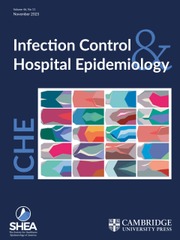No CrossRef data available.
Article contents
Do blood contamination reduction devices work? A single institution comparison
Published online by Cambridge University Press: 25 November 2024
Abstract
We compare two initial specimen diversion devices evaluated over 3 months to investigate their utility in lowering blood culture contamination rates at or below 1%. Overall contamination rates during trial periods were 2.46% and 2.60% but usage was low, whereas device-specific contamination rates were 0.68% and 0.8%, respectively.
- Type
- Concise Communication
- Information
- Copyright
- © The Author(s), 2024. Published by Cambridge University Press on behalf of The Society for Healthcare Epidemiology of America
References
Centers for Disease control and Prevention. Blood culture contamination: an overview for infection control and antibiotic stewardship programs working with the clinical laboratory. https://www.cdc.gov/antibiotic-use/core-elements/pdfs/fs-bloodculture-508.pdf. Accessed April 20, 2022.Google Scholar
Geisler, BP, Jilg, N, Patton, RG, Pietzsch, JB. Model to evaluate the impact of hospital-based interventions targeting false-positive blood cultures on economic and clinical outcomes. J Hosp Infect 2019;102:438–444. doi: 10.1016/j.jhin.2019.03.012.CrossRefGoogle ScholarPubMed
Clinical and Laboratory Standards Institute. Principles and Procedures for Blood Cultures, 2nd edition. Wayne PA: CLSI Document M47-E2. Clinical and Laboratory Standards Institute; 2022.Google Scholar
Sen Heinrich, M. [D-N. Text - S.2604 - 117th Congress (2021-2022): Military Construction, Veterans Affairs, and Related Agencies Appropriations Act, 2022 (2021-08-04) [Legislation]. http://www.congress.gov/bill/117th-congress/senate-bill/2604/text. Accessed August 4, 2021.Google Scholar
Doern, G. V., Carroll, K. C., Diekema, D. J., et al. Practical guidance for clinical microbiology laboratories: a comprehensive update on the problem of blood culture contamination and a discussion of methods for addressing the problem. Clin Microbiol Rev 2019;33:e00009–19. https://doi.org/10.1128/CMR.00009-19
CrossRefGoogle Scholar
Gibson, T, Norris, W. Skin fragments removed by injection needles. Lancet 1958;2:983–5. doi: 10.1016/s0140-6736(58)90475-6.CrossRefGoogle ScholarPubMed
Buchta, C, Nedorost, N, Regele, H, et al. Skin plugs in phlebotomy puncture for blood donation. Wien Klin Wochenschr 2005;117:141–4. doi: 10.1007/s00508-005-0310-6.CrossRefGoogle ScholarPubMed
Tompkins, LS, Tien, V, Madison, AN. Getting to zero: Impact of a device to reduce blood culture contamination and false-positive central-line-associated bloodstream infections. Infect Control Hosp Epidemiol 2023;44:1386–1390. doi: 10.1017/ice.2022.284.CrossRefGoogle ScholarPubMed
Rupp, M. E., Cavalieri, R. J., Marolf, C., & Lyden, E. Reduction in blood culture contamination through use of initial specimen diversion device. Clin Infect Dis 2017;65:201–205. https://doi.org/10.1093/cid/cix304
CrossRefGoogle ScholarPubMed
Zimmerman, FS, Assous, MV, Yinnon, AM, Wiener-Well, Y. Reducing blood culture contamination using a departmental report card. J Hosp Infect 2018;99:236–237. doi: 10.1016/j.jhin.2018.02.023.CrossRefGoogle ScholarPubMed



